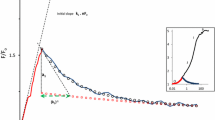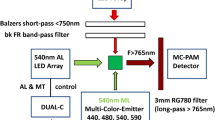Abstract
The investigation of the kinetics of chlorophyll-fluorescence under continuous background light enables the application of linearizing conditions. This approach, which provides a quantitative evaluation by means of curve-fitting routines, is applied to the investigation of the linear kinetics of the I-D-P phase. Using changes in PS II-light, PS I-light and in CO2-concentration as input signals showed that a pool at the acceptor side of PS I, in addition to the plastoquinone pool, plays an essential role in the generation of the dip. The occurrence of the dip is related to the sign of the faster one of the two components related to the I-D and the D-P phase. This sign can be inverted by the ratio of PS I and PS II light. However, model calculations show that the change of this sign does not allow a decision which one of the two components is related to which one of the two pools. The dependence of the sign of the faster component on light conditions can generate different types of I-D-P transitions, namely nearly monophasic increases, sigmoid responses or dips. As these phenomena are already created by the linear responses, non-linear effects or additional loops between PS II and PS I are not required for the explanation of the basic features.
Similar content being viewed by others
Abbreviations
- ETC:
-
electron transfer chain
- F:
-
fluorescence
- PQ:
-
plastoquinone pool
- PS:
-
Photosystem
- X:
-
pool at the acceptor side of PS I
References
Baake E and Strasser RJ (1990) A differential equation model for the description of the fast fluorescence rise (O-I-D-P-transient) in leaves. In: Baltscheffsky M (ed) Current Research in Photosynthesis, Vol I, pp 567–570 Dordrecht. Boston, London: Kluwer Academic Publishers
Dau H and Canaani O (1990) The involvement of LHC phosphorylation in the adaptation of higher plants to changing light intensities and some results on the regulation of LHC 2 phosphorylation in vivo. In: Baltscheffsky M (ed) Current Research in Photosynthesis, Vol I, pp 325–328. Dordrecht, Boston, London: Kluwer Academic Publishers
Dau H and Hansen UP (1989) Studies on the adaptation of intact leaves to changing light intensities by a kinetic analysis of chlorophyll fluorescence and oxygen evolution as measured by the photoacoustic signal. Photosynth Res 20: 59–83
Dau H and Hansen UP (1990) A study on the energy-dependent quenching of chlorophyll fluorescence by means of photoacoustic measurements. Photosynth Res 25: 269–278
Eichelmann H, Weis E and Laisk A (1990) The effect of electron cycling around PS II on fluorescence induction: mathematical modelling. In: Baltscheffsky M (ed) Current Research in Photosynthesis, Vol I, pp 663–666. Dordrecht, Boston, London: Kluwer Academic Publishers
Eigen M (1968) New looks and outlooks in physical enzymology. Quart Rev Biophys 1(1): 3–33
Hansen UP (1978) Do the light-induced changes in the membrane potential of Nitella reflect the feed-back regulation of a cytoplasmic parameter? J Membrane Biol 41: 197–224
Hansen UP (1982) Kinetic analysis of regulation of transport. In: Martonosi A (ed) Membranes and Transport: A Critical Review, Vol 2, pp 639–644. New York and London: Plenum Press
Hansen UP (1985) Messung und reaktionskinetische Interpretation der Kinetik der Lichtwirkung auf den elektrophoretischen Transport über die Plasmamembran der Alge Nitella. Ber Deutsch Bot Ges 98: 105–118
Hansen UP, Kolbowski J and Dau H (1987) Relationship between Photosynthesis and Plasmalemma Transport. J Exp Bot 38: 1965–1981
Hansen UP, Kolbowski J, Vanselow KH, Dau H and Lübke P (1989) Möglichkeiten eines Biotests mit Hilfe der linearen Analyse der Kinetik der Signale aus dem photosynthetischen Apparat I. Grundlagen und theoretischer Hintergrund. In: Ernst D and Schmidt C (eds) Grundlagen und Anwendungsbereiche der Chlorophyll-Fluoreszenz, Dortmunder Beiträge zur Wasserforschung 37: 96–116
Jennings RC and Forti G (1975) Fluorescence induction in intact spinach chloroplasts. Biochim Biophys Acta 396: 63–71
Krause GH and Weis E (1984) Chlorophyll fluorescence as a tool in plant physiology. II. Interpretation of fluorescence signals. Photosynth Res 5: 139–157
Martens J, Hansen UP and Warncke J (1979) Further evidence for the parallel-pathways model obtained from the high-frequency slope of the light effect on the membrane potential in Nitella. J Membrane Biol 48: 115–139
Munday JCJr and Govindjee (1969) Light-induced changes in the fluorescence yield of chlorophyll a in vitro. III. The dip and the peak in the fluorescence transient of Chlorella pyrenoidosa. Biophys J 9: 1–21
Renger G and Schulze A (1985) Quantitative analysis of fluorescence induction curves in isolated spinach chloroplasts. Photobiochem Photobiophys 9: 79–87
Satoh K and Katoh S (1981) Fluorescence induction in chloroplasts isolated from the green alga, Bryopsis maxima IV. The I-D dip. Plant Cell Physiol 22: 11–21
Schreiber U and Vidaver W (1974) Chlorophyll fluorescence induction in anaerobic Scenedesmus obliquus. Biochim Biophys Acta 368: 97–112
Schreiber U and Vidaver W (1976) The I-D transient. An indicator of rapid energy distribution changes in photo-synthesis. Biochim Biophys Acta 440: 205–214
Schreiber U, Schliwa U and Bilger W (1986) Continuous recording of photochemical and non-photochemical chlorophyll fluorescence quenching with a new type of modulation fluorometer. Photosynth Res 10: 51–62
Vanselow KH and Hansen UP (1989a) The rapid effect of light on the K+-channel in Nitella. J Membrane Biol 110: 175–187
Vanselow KH and Hansen UP (1989b) Möglichkeiten eines Biotests mit Hilfe der linearen Analyse der Kinetik der Signale aus dem photosynthetischen Apparat III. Off-line Analyse der Chlorophyll-Fluoreszenzkinetik mit rauschigem Licht. In: Ernst D and Schmidt C (eds) Grundlagen und Anwendungsbereiche der Chlorophyll-Fluoreszenz. Dortmunder Beiträge zur Wasserforschung 37: 96–116
Vanselow KH, Kolbowski J and Hansen UP (1989a) Further evidence for the relationship between light-induced changes of plasmalemma transport and transthylakoid proton uptake. J Exp Bot 40: 239–245
Vanselow KH, Kolbowski J and Hansen UP (1989b) Analysis of chlorophyll-fluorescence by means of noisy light. J Exp Bot 40: 247–256
Walker DA (1988) Some aspects of the relationship between chlorophyll a fluorescence and photosynthetic carbon assimilation. In: Lichtenthaler HK (ed) Applications of Chlorophyll Fluorescence, pp 13–20. Dordrecht, Boston, London: Kluwer Academic Publishers
Author information
Authors and Affiliations
Rights and permissions
About this article
Cite this article
Hansen, UP., Dau, H., Brüning, B. et al. Linear analysis applied to the comparative study of the I-D-P phase of chlorophyll fluorescence as induced by actinic PS-II light, PS-I light and changes in CO2-concentration. Photosynth Res 28, 119–130 (1991). https://doi.org/10.1007/BF00054125
Received:
Accepted:
Issue Date:
DOI: https://doi.org/10.1007/BF00054125




